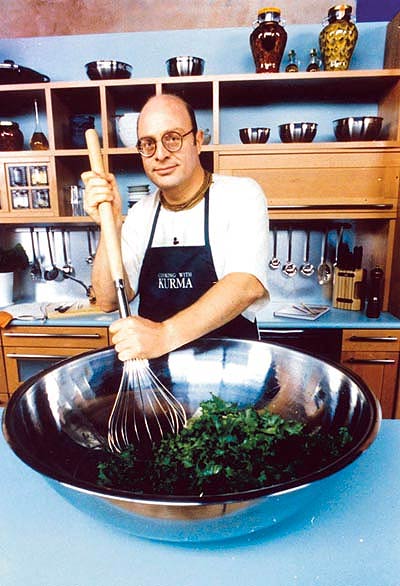Dishes With a Difference
By Rosslyn Beeby | Окт 21, 2007

They’ve got loose pages, ghee-spattered covers and smidges of turmeric marking favourite recipes. One was published in 1973 but its vintage recipes still outperform many of those found in latter-day lavishly illustrated cookbooks. It has the best recipe for potato kachoris, and the gajja kheer (grated carrots simmered in milk, with sugar, almonds and cardamom) is a party-stopper. Far tastier, and healthier, than Nigella Lawson’s famous deep-fried Mars bars.
Over the years, vegetarian cooking has had its share of fads. Remember Gail Duff’s penchant for wheatgerm with just about everything or Rose “Not Just a Load of Old Lentils” Elliot’s enthusiasm for hearty bean hotpots and grated cheese toppings? During her pre-French regional cuisine and wicked-puddings period, British glamour chef Annie Bell flirted with a minimalist cuisine minceur style of vegetarian cooking. I’m a fan of her sticky gingerbread, but her vegie cookbook failed to hit the mark and was dispatched to the local second-hand bookshop within weeks.
But for tasty, fragrantly spicy vegetarian food that hits the palate with a burst of flavour, you can’t beat the Hare Krishna cookbooks, or the recipes of Krishna chef extraordinaire Kurma Dasa. After a couple of decades of vegetarian cooking, I wouldn’t part with my dog-eared copies they’re as reliable as a tennis ball-retrieving border collie and as inspirational as Emily-Lou Harris hitting those ethereal high notes.
In the early 1970s, conga-lines of chanting, drumming, cymbal-crashing Krishnas threaded their way through the inner streets of Melbourne during lunch hour, proffering cards inviting people to eat at Gopal’s, their first-floor restaurant in Flinders Street. Word quickly spread among students and the city’s arty set that this was the place to eat. Musicians Billy Thorpe and Lobby Lloyd were regulars, and artist Peter Booth still rates it as a favourite. Word also spread that the food at Gopal’s was especially fantastic when the big bloke with the glasses was running the kitchen.
Unlike the usual stodge fried rice with frozen peas and cauliflower, baked beans or mashed potatoes served with diced carrots and limp green beans served up to vegetarians at university cafeterias, the food at Gopal’s was fantastic. You could also snaffle a free recipe book, The Higher Taste, to try to recreate those tasty curries and desserts at home.
While Gail Duff was earnestly trying to convince readers of the virtues of wheatgerm as an all-purpose garnish, the Krishna cookbooks were way out in front in their cross-cultural culinary approach. Back in the ’70s, they were explaining how to make calzone, enchiladas (without the supermarket packet mixes), vegetarian kofta, panir and Chinese tofu spring rolls spiced with ginger.
As a young journalist with a Melbourne newspaper, I took one of the city’s notoriously picky food critics to Gopal’s. We were catching a tram downtown for lunch, and he was shocked to hear my destination was, as he sniffily put it, “the Hare Krishna canteen”. Was I so broke I couldn’t afford a nice camembert and salad bagel in an upmarket sandwich bar? He offered to shout me lunch, obviously out of pity that my options had sunk so low, and I dared him to put his prejudices on hold and join me.
He’d expected a plonk-it-on-your-plate curry ‘n rice joint, with a chewy pappadum on the side, washed down with weak, milky tea. Instead, he was contemplating a well-presented choice of spicy dhals, Indian breads, samosas, vegetables in yoghurt or tomato sauces and desserts flavoured with pistachio and powdered cardamom. Who on earth did the cooking, he asked. As usual, it was the big bloke with glasses. “Whoever he is, he’s bloody good,” was the critic’s verdict, before ducking back into the lunch queue for seconds.
The big bloke with the glasses was, of course, Kurma Dasa now known to millions around the world for his books, Cooking with Kurma, Great Vegetarian Dishes and Vegetarian World Food, and his hugely successful television series that’s been screened across the United States, Britain, the Middle East, Russia, Turkey, Malaysia and China. His first cookery book, published 14 years ago, is now in its seventh print run which makes him one of Australia’s best-selling authors.
Earlier this month, Kurma was back in Melbourne helping to prepare 1000 gulab jamuns (milk balls in a rose-scented syrup) to mark the birthday of the founder of the Hare Krishna movement, Srila Prabhupada.
We were so lucky to have him running the Gopal’s kitchen back in the days when many vegetarian cookbooks offered unremittingly dull fare. We might not have converted to Krishna consciousness (rising at 4am for devotional chanting could have been a factor there), but Kurma and the Krishnas did win millions of hearts and palates with joyously adventurous vegetarian cooking that was well ahead of its time.
For Kurma Dasa recipes go to www.kurma.net















